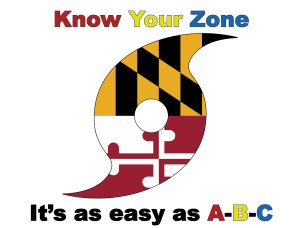Maryland Launches “Know Your Zone” Hurricane Preparedness Campaign
Program Designed to Ease Evacuation in Areas Subject to Tidal Floods, Surge
REISTERSTOWN, Md. (June 14, 2018) — With the record-setting 2017 hurricane season still fresh in most American’s minds, the Maryland Emergency Management Agency (MEMA), in conjunction with local emergency managers, is rolling out a new hurricane and severe weather evacuation system as a result of the Maryland hurricane evacuation study which concluded earlier this year. The study identified 3 large areas in Maryland subject to tidal flooding. Know Your Zone aims to bring awareness of the evacuation zones to the forefront of Marylanders’ summer plans and make evacuation notices easier to disseminate.
The National Oceanic and Atmospheric Administration recently released its forecast for the upcoming season and predicted near- to above-normal activity. However, it only takes one storm hitting the mid-Atlantic area to seriously affect Maryland.
“As experts are forecasting an active Hurricane season this year, I strongly encourage all Marylanders to be proactive, prepared, and to Know Your Zone,” said Governor Hogan. “We are all too familiar with the devastating impacts of severe weather and flooding, so remain vigilant, spread the word to your friends, family, neighbors and let them know about the importance of this potentially life-saving initiative.”
Residents of and visitors to Maryland are encouraged to visit the new interactive Know Your Zone web page, www.KnowYourZoneMd.com, where they can learn more about the project. On that page, you can type in an address and quickly find out what zone, if any, the property is located in.
The first year of the program will encourage Maryland residents to know the evacuation zone of their residence, business or vacation site. The zones are designated by letters A, B and C.
Zone A areas are the most likely to be impacted by severe flooding in the event of a major storm or hurricane. In future years, the program will focus on refining evacuation routes away from the affected areas. “Proper and timely messaging for evacuations saves lives,” said MEMA Executive Director Russ Strickland. “This new system is designed to make it easier for local emergency managers to evacuate areas by encouraging Marylanders to Know Your Zone before a storm hits.”
The three evacuation zones only affect areas subject to tidal flooding or storm surge – communities at or near the Atlantic Ocean, the Coastal Bays, and the Chesapeake Bay and its tributaries. That covers 16 Maryland counties along with Annapolis, Baltimore City and Ocean City.
“Hurricane Sandy in 2012 was a wake-up call for the mid-Atlantic region; it could have been Maryland,” said Strickland. “Working with local and federal partners, and using technology that until recently was not available, we studied updated flooding and surge patterns caused by more powerful storms to develop these new evacuation plans.”
If local officials feel an evacuation is needed to protect lives, they will issue the order by zones instead of having to define specific geographic areas. This program is similar to one rolled out last year in neighboring Virginia.
The Atlantic hurricane season runs from June to November. Hurricanes can cause strong winds, heavy rain, inland flooding and other severe weather, but residents in Maryland can be prepared by ensuring they know how to receive a warning, have a plan, practice safety tips and know their evacuation zone.
It is important to remember Maryland can see hurricanes and impacts from a storm hundreds of miles away. Hurricanes can produce 150-plus miles per hour winds, tornadoes and tremendous flooding from both tidal surges as well as torrential rain
Residents can also take the following actions to remain safe:
- Build an emergency supply kit and develop a family emergency and communications plan.
- Stay tuned to trusted sources such as the National Weather Service and local broadcasters for official weather information.
- Follow instructions and advice given by emergency officials, especially instructions related to evacuation.
- During severe weather, stay indoors away from windows, close all interior doors, and brace external doors. If you live near the shore or coast, expect the storm tide will inundate your home.
- Monitor NWS flood warnings for your area and be prepared to seek higher ground. Flooding is often our biggest threat.
- Fill a bathtub or other large container with water for sanitary purposes such as cleaning and flushing toilets.
- Charge electronic devices before bad weather hits and consider keeping a charger in your car.
Additional preparedness information can be found on MEMA’s website at mema.maryland.gov. Residents can download the free MARYLAND Prepares mobile app. They can also follow MEMA on Twitter or on Facebook.

